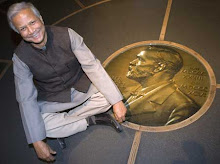Global Worries Over U.S. Stimulus Spending
By NELSON D. SCHWARTZ
Michel Euler/Associated Press
At Davos, Bill Clinton greets Muhammad Yunus, the Nobel Peace Prize laureate, with Tony Blair, Jet Li and Bill Gates.
DAVOS, Switzerland — Even as Congress looks for ways to expand President Obama’s $819 billion stimulus package, the rest of the world is wondering how Washington will pay for it all.
Few people attending the World Economic Forum question the need to kick-start America’s economy, the world’s largest, with a package that could reach $1 trillion over two years. But the long-term fallout from increased borrowing by the United Stated government, and its potential to drive up inflation and interest rates around the world, seems to getting more attention here than in Washington.
“The U.S. needs to show some proof they have a plan to get out of the fiscal problem,” said Ernesto Zedillo, the former Mexican president who helped steer his country through a financial crisis in 1994. “We, as developing countries, need to know we won’t be crowded out of the capital markets, which is already happening.”
Mr. Zedillo said that Washington, unlike most other countries, had the option of simply printing more money, because the dollar was a reserve currency for the rest of the world. Over the long run, that could force long-term interest rates higher and drive down the value of the dollar, undermining the benefits that come with its special status. Until now, most fears about surging government debt have focused on borrowing by European countries like Spain, Greece and especially Britain, which is also in the midst of a sizable bank bailout. That recently forced the British pound to a 23-year low against the dollar. While the dollar’s status as refuge in a time of turmoil should prevent that kind of sell-off for now, a number of financial specialists warned that if fundamental factors like the lack of American savings and bloated budget deficits did not change, the dollar could eventually fall sharply. “There aren’t that many safe havens,” said Alan S. Blinder, a Princeton economist who is a former vice chairman of the Federal Reserve in Washington, explaining why the dollar’s status as a reserve currency is unlikely to be threatened. Instead, it is the dollar’s long-term value against other currencies that is vulnerable. “At some point, there may be so much Treasury debt, that investors may start wondering if they are overloaded in dollar assets,” Mr. Blinder said.
While the focus in Washington has been on putting together a stimulus package that will attract broader political support when it comes up for a vote in the Senate, here in Davos the talk has been about the coming avalanche of Treasury debt needed to pay for the plan on top of the bailout measures approved last fall, like the $700 billion Troubled Asset Relief Program, or TARP. The stimulus was approved Wednesday by the House without Republican support, and could grow larger — mostly likely with additional tax cuts — to attract a bipartisan coalition.
American officials maintain they are aware of the challenge. A top White House adviser, Valerie Jarrett, promised in Davos on Thursday that once the stimulus plan achieved its intended affect, the United States would “restore fiscal responsibility and return to a sustainable economic path.” To be sure, Congress and the White House will ultimately need to refill the government’s coffers, but how they might do that is barely on the radar screen in Washington at this point.
“Even before Obama walked through the White House door, there were plans for $1 trillion of new debt,” said Niall Ferguson, a Harvard historian who has studied borrowing and its impact on national power. He now estimates that some $2.2 trillion in new government debt will be issued this year, assuming the stimulus plan is approved.
“You either crowd out other borrowers or you print money,” Mr. Ferguson added. “There is no way you can have $2.2 trillion in borrowing without influencing interest rates or inflation in the long-term.” Mr. Ferguson was particularly struck by the new borrowing because the roots of the current crisis lay in an excess of American debt at all levels, from homeowners to Wall Street banks. “This is a crisis of excessive debt, which reached 355 percent of American gross domestic product,” he said. “It cannot be solved with more debt.”
While Mr. Ferguson is a skeptic of the Keynesian thinking behind President Obama’s plan — rather than borrowing and spending to stimulate the economy, he favors corporate tax cuts — even supporters of the plan like Mr. Zedillo and Stephen Roach of Morgan Stanley have called on the White House to quickly address how it will pay for the spending in the long-term. “It’s huge,” Mr. Roach, the chairman of Morgan Stanley Asia, said. “President Obama has now laid out a scenario of multiyear, trillion-dollar deficits.”
The stimulus is widely expected to pass, but once it does, Mr. Roach said the focus would shift to “who foots the bill and what is the exit strategy. We don’t have the answer to either question.”
Mr. Zedillo, who remembers how Mexico was forced to tighten its belt when it received billions from Washington to keep its economy from collapsing in 1994, was even blunter.
“People are not stupid,” Mr. Zedillo said. “They see the huge deficit, the huge spending, and wonder what comes next.”
Alessandro Della Bella/European Pressphoto Agency
Ernesto Zedillo, the former president of Mexico.
Adam Berry/Bloomberg News
Tony Blair, the former British prime minister, speaking at the World Economic Forum in Davos, Switzerland. Fears about surging government debt, once focused on Britain and other European countries, are now turning to the United States.



No comments:
Post a Comment